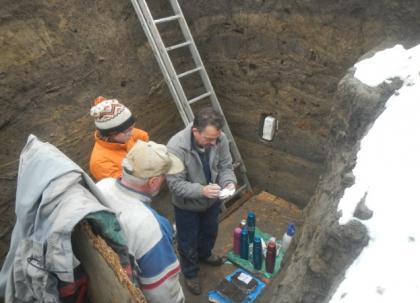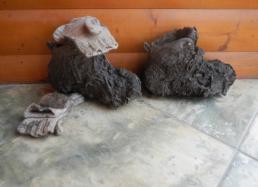3. Ez fáj! (This hurts!)
We finally managed to get into the field last Thursday after the snows, rain, sleet, and hail. As I mentioned in my last dispatch, we lost several days the first two weeks to the weather, and it was a darn good thing we got a small window to get the big backhoe into the tell to clear out the deep trench we identified last year. Exposing the tell trench was critical because we needed to prepare for the newest addition to our team—Dr. Panagiotis (Takis) Karkanas (Ephoreia of Palaeoanthropology-Speleology of Southern Greece)—to do his work there.
Takis is a geoarchaeologist who, among many other things, studies the stratigraphy and micromorphology of archaeological sites (see above photo.) He takes samples of archaeological layers in big chunks (columns), impregnates them with a resin to make them rock hard, and then grinds them down to make translucent slides that he can examine using a microscope. This permits Takis to investigate—at the microscopic scale—the ancient behaviors that together created the sites we're digging.
When we look at a stratigraphic profile, like the one at the Szeghalom-Kovácshalom tell, we can distinguish many layers that were created by people at different times during the Neolithic period. But Takis can look at just one of those layers under a microscope and identify many more individual episodes (layers) that we cannot see with the naked eye. This kind of information is absolutely critical for understanding how these sites were created and grew over time.
Although we got out to the site on Thursday, we lost Friday to the weather. On Saturday I drove to Budapest to pick up Takis and Dr. Apostolos Sarris, who is the leader of our geophysics team. He'll continue his work identifying the edges of the site, which keeps getting bigger every year.
I got to spend most of Saturday in a warm truck, but the rest of the team made a heroic effort to get out to the site. It didn’t rain, but it was still horribly cold and muddy. Take a look at their "Stuck in the Mud" Video Journal, which shows the (somewhat comical) attempt of some of our team to make it back to the trucks at the end of the day. Note that it was just above freezing when all this went down! (And take a look at Photo #1 below to see the muddy shoes recovered from the muck during the video.)
Saturday night we participated in a special project tradition. Each year, our Hungarian mother, Mrs. Marika Csóti, who has cooked for us for the last thirteen years, hosts a party where our team members get to participate in the ancient rural Hungarian tradition of butchering a pig. For many American students who think that all meat comes pre-wrapped from the grocery store, this can be a very eye-opening experience.
Sunday and Monday we got out to the site, but then another huge snowstorm hit Monday afternoon, and we lost all of Tuesday. On Wednesday, a few hearty members trudged out through the snow to help Takis collect samples and to conduct some geophysical prospection. We're not in the field today because it has been snowing for three days straight, and as my "Sloshing & Screening" Video Journal shows, even walking the short distance from the edge of the trench to the screen can be an arduous task, not to mention sifting through all that mud.
Despite all the horrible weather, we're still making progress, albeit slowly. We collected the micromorphological samples from the tell yesterday and hauled them the three long, wet kilometers to the car. The team in the northern block (N1B2) has also fully exposed the daub on the northern part of the big longhouse. Take a look at my "Difficult Digging" Video Journal, which shows how difficult it is to shovel through the heavy muck and expose archaeological features. (The video is in Hungarian, but suffice it to say that I'm manning the camera and having a sarcastic discussion with my hard-at-work colleagues about the lovely weather.)
More soon—our spirits remain high, and we're optimistic that we'll be able to get a lot of work done as soon as the weather starts to cooperate!
Bill




